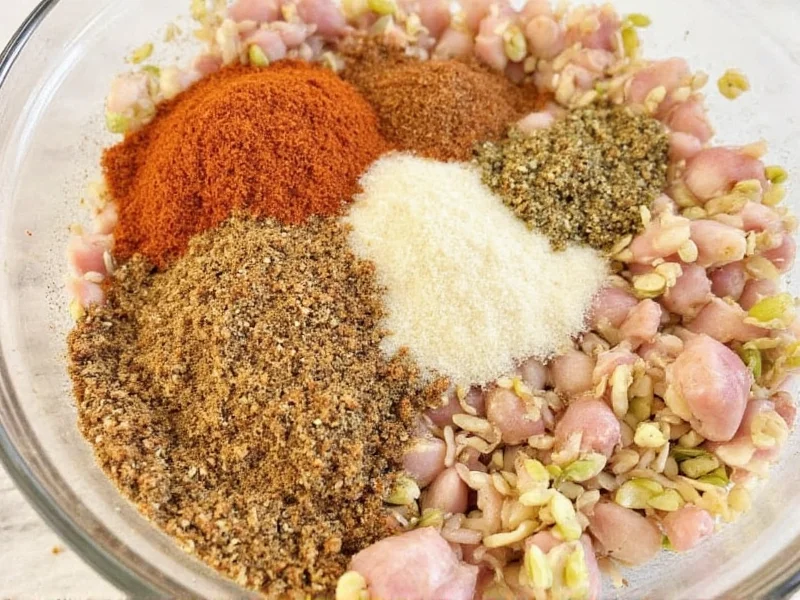Homemade poultry seasoning offers superior flavor and control compared to store-bought versions. When you make your own poultry seasoning blend, you avoid unnecessary additives, adjust flavors to your preference, and ensure maximum freshness. This versatile spice mix forms the aromatic foundation for countless poultry dishes, from Thanksgiving turkey to weeknight chicken recipes.
Understanding Poultry Seasoning Components
Poultry seasoning isn't a single ingredient but a carefully balanced blend of herbs that complement chicken, turkey, and other birds. Each component serves a specific purpose in creating that familiar, comforting flavor profile:
| Ingredient | Flavor Profile | Function in Blend |
|---|---|---|
| Dried Sage | Earthy, slightly peppery | Provides the dominant, traditional poultry flavor |
| Dried Thyme | Subtly minty, lemony | Adds complexity and balances sage's intensity |
| Dried Marjoram | Sweet, floral, milder than oregano | Contributes warmth without overpowering |
| Dried Rosemary | Pine-like, robust | Adds depth in small quantities |
| Black Pepper | Sharp, pungent | Provides necessary heat and dimension |
Step-by-Step Homemade Poultry Seasoning Recipe
Follow these precise steps to create a professional-quality poultry seasoning blend that rivals commercial versions:
- Gather 100% pure dried herbs with no fillers or anti-caking agents
- Measure ingredients precisely using standard measuring spoons
- Combine 4 tablespoons dried sage, 2 tablespoons dried thyme, 2 tablespoons dried marjoram, 1 tablespoon dried rosemary, 1 tablespoon dried parsley, 1 teaspoon black pepper, and 1 teaspoon dried rubbed sage
- Place all ingredients in a small bowl
- Whisk thoroughly for 1-2 minutes to ensure even distribution
- Transfer to an airtight glass container away from direct light
- Label with creation date and "Use by" date (6 months from preparation)
Customizing Your Poultry Seasoning Blend
One advantage of making your own poultry seasoning is the ability to tailor it to your specific tastes and cooking needs. Consider these professional adjustments for different applications:
- For roasting whole birds: Add ½ teaspoon garlic powder and ½ teaspoon onion powder to help the seasoning adhere to skin and create better browning
- For delicate dishes like chicken piccata: Reduce sage by 50% and increase parsley for a lighter flavor profile
- For game birds: Increase rosemary by 50% to complement stronger flavors
- For stuffing/dressing: Add ½ teaspoon celery seed for traditional holiday flavor
- For dietary restrictions: Omit black pepper for pepper-sensitive individuals and increase thyme by 1 tablespoon
Proper Storage Techniques for Maximum Freshness
Dried herbs lose potency over time, so proper storage determines how long your homemade poultry seasoning maintains peak flavor. Follow these storage guidelines for best results:
- Use amber or cobalt glass containers to protect from light degradation
- Store in a cool, dark cupboard away from stove or oven heat
- Maintain consistent temperature (avoid refrigerator due to moisture)
- Use within 6 months for optimal flavor (mark container with preparation date)
- Never store above 75°F (24°C) as heat accelerates flavor loss
- Always use dry utensils when measuring to prevent moisture contamination
Application Tips for Perfectly Seasoned Poultry
Knowing how to apply your homemade poultry seasoning makes a significant difference in final results. Professional chefs use these techniques:
- For whole birds: Mix 2 tablespoons seasoning with 2 tablespoons softened butter, then gently separate skin from meat and rub mixture directly on the bird before roasting
- For cut-up chicken: Toss pieces with 1-2 tablespoons seasoning and 1 tablespoon oil before cooking to ensure even coating
- For stuffing: Add 1-2 tablespoons to your bread mixture for authentic flavor
- For gravy: Whisk 1 teaspoon into your roux for cohesive flavor throughout
- For brines: Dissolve 2 tablespoons in your brine solution for deep flavor penetration
Common Mistakes to Avoid When Making Poultry Seasoning
Even experienced home cooks make these errors when creating homemade poultry seasoning. Avoid these pitfalls for best results:
- Using old or stale spices: Test your base herbs by rubbing a small amount between fingers—if aroma is weak, replace them
- Inconsistent measurements: Always use level measurements, not heaping spoons, for proper balance
- Skipping the whisking step: Uneven distribution leads to some bites being overly sage-heavy
- Adding salt to the blend: Keep salt separate as different dishes require varying salt levels
- Storing in plastic containers: Glass preserves flavor better than plastic which can absorb odors
- Using fresh herbs: Dried herbs have concentrated flavor essential for proper seasoning balance
Why Homemade Beats Store-Bought Poultry Seasoning
Commercial poultry seasoning often contains fillers like flour, salt, and anti-caking agents that dilute flavor. When you make your own poultry seasoning blend from scratch, you control exactly what goes into it. Most store-bought versions use lower-quality herb cuts and may contain up to 30% fillers. Your homemade version will have brighter, more vibrant flavors because you're using pure, fresh herbs without unnecessary additives. Additionally, you can adjust the blend to match regional preferences or dietary needs—something impossible with mass-produced versions.











 浙公网安备
33010002000092号
浙公网安备
33010002000092号 浙B2-20120091-4
浙B2-20120091-4